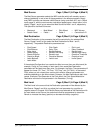
Chapter 7: Editing Effects
REVERB
Reverb can be thought of as a great number of distinct echoes, called reflections, that
occur so fast that our ear hears them blurred together as one. In nature, different sized
spaces give distinctly different sounding reverbs, depending on the size and shape of
the space, and the texture of surfaces that the reflections bounce off of. The various
parameters in the effects processor make it possible to simulate nearly any natural
reverberant space that can be imagined, and a few artificial ones as well.
ED:MIX FX SND1πå
RVB-IN1:PITCHout
The Reverb function is used to edit Reverb input levels and other parameters. In all
configurations, page 1 of the Reverb function selects what the reverb is “hearing” (i.e.,
where the input of the reverb is coming from). The source can come directly from the
Effect bus, the output of other effects in the chain before it, or a mix of several of them.
Example: In Configuration #1, page 1 of the Reverb function (shown above) allows
you to select the first of two sources to be routed to the reverb’s input. You can
choose from the Delay output or the Pitch output. In page 2, you can choose the
second input for the reverb to process, which can be the dry, send 1 signal, the Delay
output or the Pitch output. You can then adjust a balance between these on page 3
and set an overall input level on page 4.
INPUT LEVELS
Input 1 Page 1 (Config 1, 3, 4 and 5)
In Configurations 1 and 3, there are two inputs to the Reverb. Both Inputs 1 and 2 can
select a signal from several locations in the signal chain. You can select either the Pitch
output or the Delay output as Input 1. If the signal is taken from the Pitch output, the
Reverb will be chorused, flanged, detuned or resonating, depending upon which Pitch
type is selected. (Note that the delay signal may already have passed through the Pitch
module, depending on the Input settings of the Delay module.)
Input 2 Page 2 (Config 1, 3, 4 and 5)
Input 2 can have as its source either the Pitch output, the Delay output, or the dry
effect send signal. If the signal is taken from the Delay output, the Reverb will be
delayed by the amount of delay time set for the Delay. If the signal is taken from the
Pitch output, the Reverb will be chorused, flanged, detuned or resonating, depending
upon which Pitch type is selected. If the signal is taken from the effect send, the
Reverb will receive direct, uneffected signal.
Input Balance (<99 to <0> to 99>) Page 3 (Config 1, 3, 4 and 5)
This allows you to control the balance between Reverb Inputs 1 and 2 and therefore
control the blend between the various input sources. This makes it possible to have
the signal from the Pitch or Delay sections, or the direct effect send in any
combination or amount.
Input level (00 to 99) Page 4 (Config 1 and 3)
This controls the overall Input Level going into the Reverb.
106 QS7/QS8 Reference Manual


















